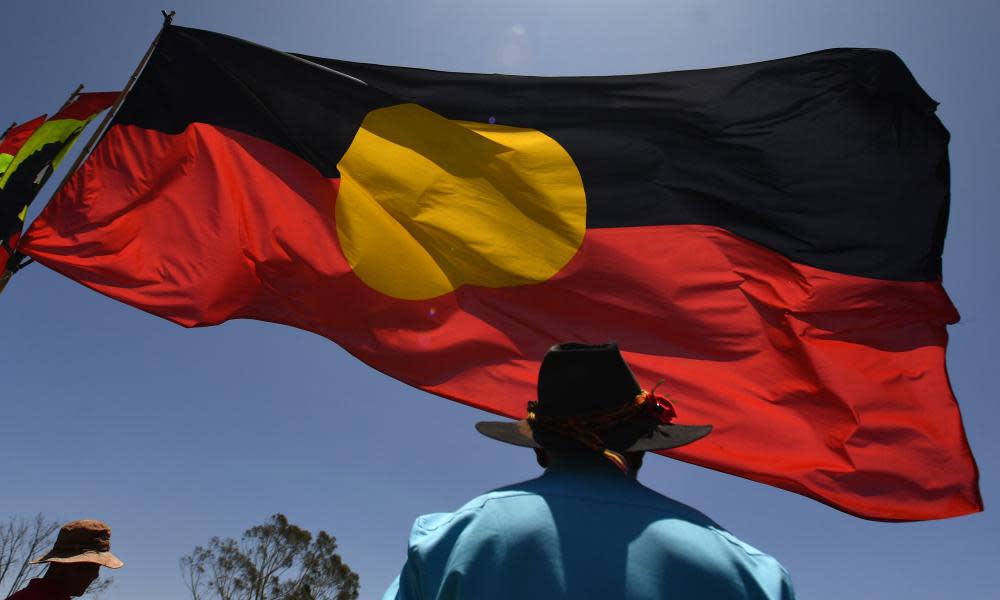'A national disgrace': 37,000 Aboriginal land claims left languishing by NSW

There are 37,000 unresolved Aboriginal land claims in New South Wales awaiting determination by the government, including the first claim lodged under the land rights act in 1984. The backlog has been described as “a national disgrace” and a form of institutional racism.
According to research seen by Guardian Australia, the backlog has built over decades.
In 2011 only 3,685 of the more than 29,587 outstanding claims had been determined, leaving 25,912 awaiting assessment. By 2016 there were 29,289 outstanding land claims, of which 197 were more than 16 years old, 520 were more than 11 years old and about 15,000 were more than six years old.
Related: Aboriginal artefacts found off WA coast prompt calls for stronger heritage laws
The chief executive of the NSW Aboriginal Land Council, James Christian, said at the current rate of processing it would take the NSW government 100 years to resolve the 37,000 claims still outstanding.
Christian said at the bureaucratic level “there’s been institutional racism, deliberate obstacles”.
“The most disappointing thing is that successive governments in New South Wales have failed to deliver on the beneficial nature of the Aboriginal Land Rights Act, which was designed to provide some compensation and remedy for ongoing effects of Aboriginal dispossession,” Christian said.
“It was intended that the process would be simple, quick and inexpensive and it would deliver vast tracts of crown land. We barely have the scraps, really, in terms of what we have been able to reacquire.
“There’s huge opportunity for our people that hasn’t been delivered on and there’s a relevant legal maxim, which is: justice delayed is justice denied.”
Land that could be used for cultural, social and economic benefit – like community housing – is effectively “frozen in time” by claim delays.
“By the time they’ve been processed, local governments have planned all their roads and infrastructure around those blocks of land. Investors don’t stick around, they move on.
“The land rights act really should be delivering us financial independence and economic prosperity and it’s failing to do that because of the continued bureaucratic obstruction.”
The NSW Aboriginal Land Rights Act was passed in 1983. Under the act, each claim goes to the minister for final approval. Land councils may appeal a ministerial decision – once the minister has signed off.
In 2018, while hearing one of those appeals, NSW Land and environment court justice Nicola Pain was highly critical of the long delays. The act did not give the minister a time frame in which to finalise claims, she said, “but on any measure the delays in finalisation of some land claims are excessive”.
“The NSW Parliament has chosen to create through the act a scheme for the making of land claims over specified crown land by land councils in specified circumstances in recognition of the dispossession of Aboriginal people.
“A practical and responsible consequence of meeting legislative obligations is that departmental resources are dedicated to achieving them.”
Some claims of more than six years old, she said “were already suffering from the danger of evidence degrading”.
A University of Wollongong researcher, John Corkill, has collected data on unprocessed land claims dating back to the act’s beginnings in 1983.
He was “horrified” to discover successive NSW governments have made “serious errors” in administering the act.
“The administration of the land rights act is not fit for purpose,” Corkill said. “It’s broken. And it’s broken because the government set out to break it.
“I’m very unhappy to discover how badly betrayed not just Aboriginal people are. But non-Indigenous people who thought that this was being made right, we’ve been double-crossed too.”
“On any analysis, this is deeply serious and the betrayal and the injustice is multi-layered, it’s fundamental and has been going on for years.
“I think it is institutionalised racism and I think it’s been the old lands department, a pillar of the white dispossession of Aboriginal people, that’s been the problem.”
The leading native title and land claims barrister Tony McAvoy SC said the 37,000 unresolved claims were a “national disgrace”.
Related: Victoria's 'silent tragedy' of Indigenous suicide sparks calls for urgent intervention
“When it was passed in 1983, the preamble to the Aboriginal Land Rights Act acknowledged that land is of spiritual, social, cultural and economic importance to Aboriginal people and that the land in NSW has been taken without compensation,” McAvoy said. He said the mechanism to provide compensation “has been ignored”.
“At the moment in NSW, we have a situation where there has been a massive amount of support for the Black Lives Matter campaign and the stop Aboriginal deaths in custody campaign.
“Part of that whole campaign is the over-representation of Aboriginal and Torres Strait Islander people in prisons and in juvenile detention centres, and in response to that, we heard one of the members of the LNP government in the Legislative Council in mid-June talk about how the over-incarceration rate was simply a product of poverty on the part of Aboriginal people.
“It seems to me that the government is trying to absolve itself from responsibility by saying it’s just a product of poverty when they are in large part the authors of that poverty,” McAvoy said. “Here you see they’ve set up a system to relieve economic inequities but failed to implement it.”
In the current government, responsibility for crown lands is shared between the minister for water, property and housing, Melinda Pavey, and the minister for planning, Rob Stokes, but claims are managed through the Department of Primary Industry and Environment. Comment has been sought from the department.

 Yahoo News
Yahoo News 
